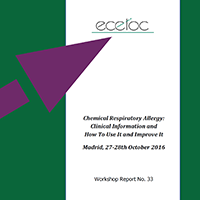Workshop Report 33: Chemical respiratory allergy: clinical information and how to use it and improve it. October 27-28 October 2016, Madrid
In a Nutshell
Brussels, March 2017 A variety of natural and man-made materials can cause allergic sensitisation of the respiratory tract in susceptible individuals. However, the mechanisms involved in the development of chemical respiratory allergy1 are currently not fully understood and no validated models exist for the identification of chemical respiratory allergens. There are also no methods suitable for the routine assessment of threshold values for sensitisation (the first stage in the development of allergy) of the respiratory tract by chemicals and thus human exposure thresholds are poorly characterised. All this creates great uncertainty surrounding the identification and safe-use of H334 (previously assigned the risk phrase R42) classified substances. A workshop was therefore held with the two main aims of:- Developing best practice guidance on how to assess and use available human data for the identification of chemical respiratory sensitisers
- Driving discussions on identifying human biomarkers for chemical respiratory sensitisation and the use of such tests to identify more accurate human threshold data, which would help refine current risk assessment approaches for the use of such materials, both from occupational and consumer exposure standpoints.
The workshop identified various areas that can drive improvements in the identification, classification and risk characterisation of respiratory sensitisers and recommended several practical steps to improve the current situation. Identified problems included the fact that, in contrast to the situation for skin sensitisation and skin irritation, where these are clearly distinguished for the purposes of classification and labelling, no similar distinction is drawn between sensitisation of the respiratory tract and respiratory irritation. Other issues include lack of clarity with respect to minimum reporting requirements, with some concern about isolated cases of respiratory allergy being used for classification, contradictions within the regulations and lack of guidance for clinicians with respect to the data that should be recorded when reporting cases of chemical respiratory allergy. A number of recommendations were made to address these problems.
Reference
WR 33: Chemical respiratory allergy: clinical information and how to use it and improve it. October 27-28 October 2016, Madrid Published March 2017 ISSN-2078-7219-33 (online) D-2017-3001-245
